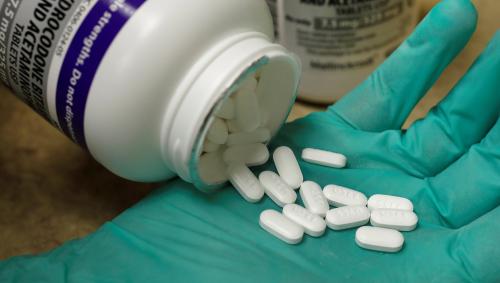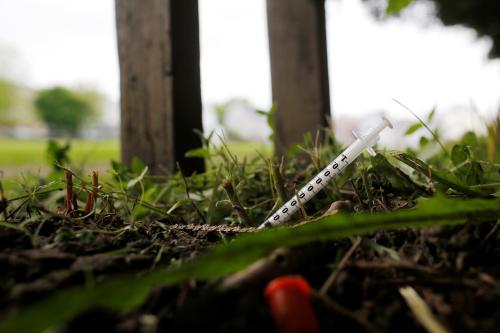“The substance use crisis, particularly opioid misuse crisis, is the most important public health challenge of our time,” said Admiral Brett P. Giroir, M.D., the assistant secretary for health at the U.S. Department of Health and Human Services, at a recent Brookings event on the opioid crisis.
Adm. Giroir’s remark occurred during a panel discussion hosted by the Governance Studies program about crafting effective policy for the opioid epidemic. Joining Adm. Giroir were Brookings Senior Fellow John Hudak, and Regina LaBelle, principal at LaBelle Strategies and a fellow with the Margolis Center for Health Policy at Duke University. Katie Zezima, national correspondent for The Washington Post, moderated the panel.
Full event and transcript is available here. Some highlights are below.
Not declaring victory
Zezima asked the panelists if existing public policy is sufficient to combat the opioid crisis, considering the rise in overdose deaths since 2016. Adm. Giroir credited HHS’ five-point strategy to empower local communities for some of the progress seen in recent data.
Adm. Giroir said that based on the most recent National Survey on Drug Use and Health (NSDUH) data, “it does look like we are making an impact on the overall crisis.” He also noted “the number of overdoses going to the emergency rooms between the third and fourth quarter of 2017 have declined for opioids almost fourteen percent, and … the mortality curves, looking at the rolling twelve months, not just 2016 to 2017 … [are hitting a plateau] and actually starting to going down.”
LaBelle, a former chief of staff in the White House Office of National Drug Control Policy (ONDCP) during the Obama administration, agreed that HHS is making important strides, stating many of the strategies currently in place have expanded on existing policies from the Obama administration. “I’m really pleased that this is one of the few areas … in Congress where we have bipartisan agreement,” she said.
However, all three panelists asserted that there is still more to be done. “What I’m not doing here is declaring victory,” said Adm. Giroir. “We have to redouble our efforts … but what I don’t want us to believe is that everything we’re doing is not making an impact.”
Changing the criminal justice system to recognize addiction
For LaBelle, increasing grant funding and expanding programs for treating opioid addiction is only the start to many necessary changes. “I see the opioid epidemic as … the on-ramp to the broader discussion about the totality of substance use disorders. We have a long way to go, and we really need to change our health care system, our treatment system, and our criminal justice system to recognize the disease of addiction, and recognize that it is a disease that can be prevented, treated, and from which people can recover.”
John Hudak also emphasized the importance of recognizing addiction as a health issue rather than a criminal one. “For too long in this country, addiction was treated as a public safety issue and not a public health issue, and because of that it de-incentivizes individuals from getting help, “ he said. “Being able to convey to individuals that you are not a criminal, you are ill, you are dealing with a medical condition … is a very important first step toward finding prevention and treatment strategies for those individuals.”
While Adm. Giroir agreed with LaBelle and Hudak, he reaffirmed that local enforcement methods still require support:
Everybody understands we cannot arrest our way out of addiction. Addiction is a disease and needs to be treated as such. That being said, I can’t have one-hundred-twenty pounds of fentanyl coming into our country on regular basis that is enough to kill thirty million people. Our job will be a whole lot easier if we could eliminate those supplies … but it’s going to take continued work and dialog and that just can’t happen in D.C. Those kinds of things have to happen at the local level as well.
No one-size-fits-all strategies
Hudak explained that a successful policy prioritizes the local levels. “One of the biggest challenges is this idea that there can be one-size fits all strategies,” he said. “What is … motivating opioid abuse disorders or overdoses in one state may be very different than the underlying forces that are causing it in another state.”
LaBelle agreed with Hudak, stating that improving policy might come “not necessarily [by] passing new laws, but looking at existing laws that stand in the way of treating the addiction as a public health issue.” Of these existing policies she asked, “What are the legal barriers, what are the policy barriers, what are the regulatory barriers?”
With the recent passage in Congress of the “SUPPORT for Patients and Communities Act,” all three panelists are optimistic about the increase in access it gives individual states and local health care practitioners. In particular, Hudak spoke positively of the increased cap on the number of patients health care providers are able to treat with buprenorphine and the elimination of Medicaid reimbursement limitations for inpatient treatment. However, Hudak agreed with criticisms of the bill, stating, “This is a small bill relative to the size of the problem.”
Both Adm. Giroir and Hudak also emphasized the importance of considering international actors as a factor in future policies. According to Hudak, especially with the rise of imported synthetic-drugs like fentanyl, strengthening foreign security and better restricting the inflow of drugs “is an important signal to individuals who are dealing with the struggle of addiction.”
Looking beyond “typical” abusers
For Hudak, it is important that future policies consider demographics beyond the scope of “typical” abusers. “Part of that broader rhetoric around treatment and prevention,” he argued, “is talking to groups who [are] non-traditionally thought of as individuals who are susceptible to use disorders. That includes, increasingly, senior citizens, veterans, retired athletes, and enormous numbers of Americans who are often forgotten in the conversation around substance use disorders who policy and efforts in this area have to begin to address and have to begin to embrace to say, ‘You are patients, too. We are here to help you.’”
Echoing LaBelle’s earlier comments, Hudak described the opioid epidemic as an on-ramp to future conversations. “I think in many ways the pervasiveness of opioid use disorders and the overdose crisis around opioids in this country have pulled that curtain back to show people that it can happen in anyone’s living room, in any family.”
Get full event video, audio, and a transcript here.
Mallory Rappaport contributed to this post.







Commentary
Highlights from a Brookings event on the nation’s opioid epidemic
October 25, 2018